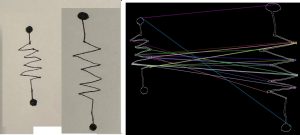One of the features that could jeopardize the progress of our project is our CV algorithm. Majority of our group’s time spent this week was researching and testing different types of image, feature, and edge detection algorithms on hand drawn circuit components. While we have made progress honing in on the type of algorithm we want to use, there is still a lot of uncertainty that needs to be solved. Since we have just been researching this week no changes have been made to our initial plan. The block diagram needs to be modified slightly. What we did not account for was our CV algorithm needing to interact with the database in order to pull training and validation data. This isn’t going to incur any extra costs or difficult refactoring because we knew we would be using a database anyways. Besides this, there are no changes to what we discussed in our proposal presentation.
Next week we would like to start testing algorithms that can separate electrical components given a whole circuit and keep experimenting with individual component detection. When researching this past week, we realized that trying to extract sub-images of the individual components from a picture of the entire circuit is harder than we thought, as per Devan’s work this week. We will likely require dots/circles at the end of each terminal of a component to mark each individual component. At this moment we have not made any scheduling changes. Prior to making the schedule, we understood that since none of us have any CV experience that deciding on an algorithm would be paramount to this project’s success and so we have dedicated time to research. Given our current progression and the deadlines that are approaching, we are confident that we can stay on track to our initial plan and finish everything we planned to finish for the next week.
We considered both public health + safety and economic factors as we developed our proposal. Firstly, our project reduces the safety risk that electricity poses to children trying to construct circuits. This is very important because parents can have peace of mind that their children will not be hurting themselves when learning about electricity. We also are aiming to reduce the cost that students and their families will incur by studying electricity and circuits. People will no longer have to pay 75+ dollars for a power supply, breadboard, wires, and resistors – instead they can just use our product for free.
Here is what comparing two drawn resistors looks like to the computer:

